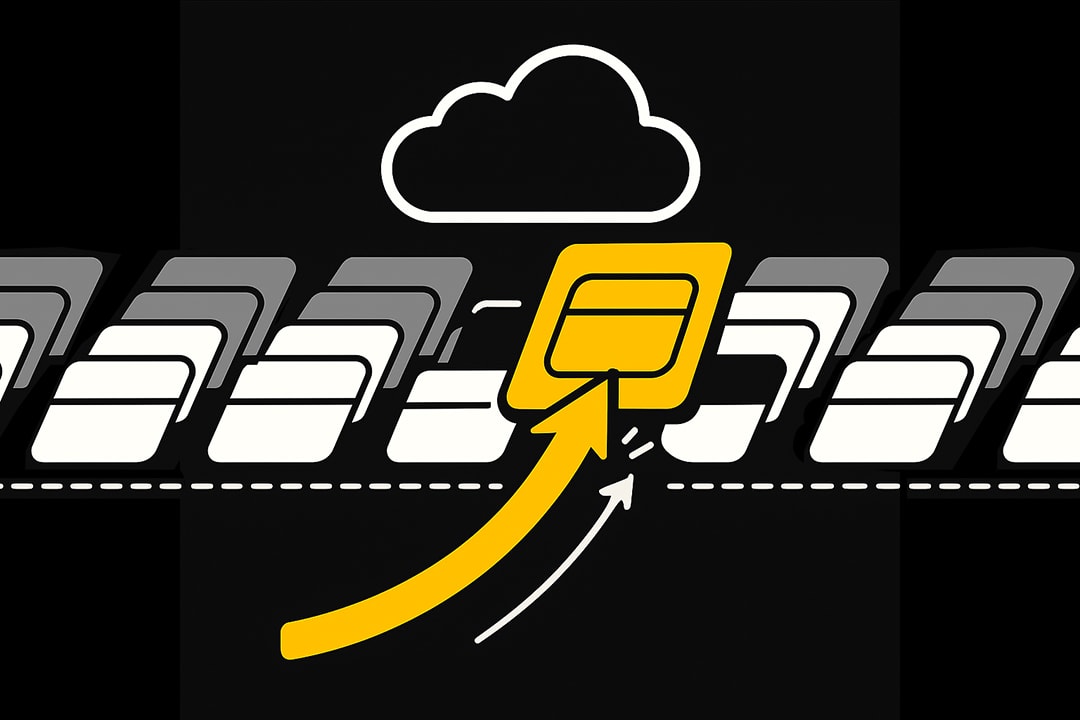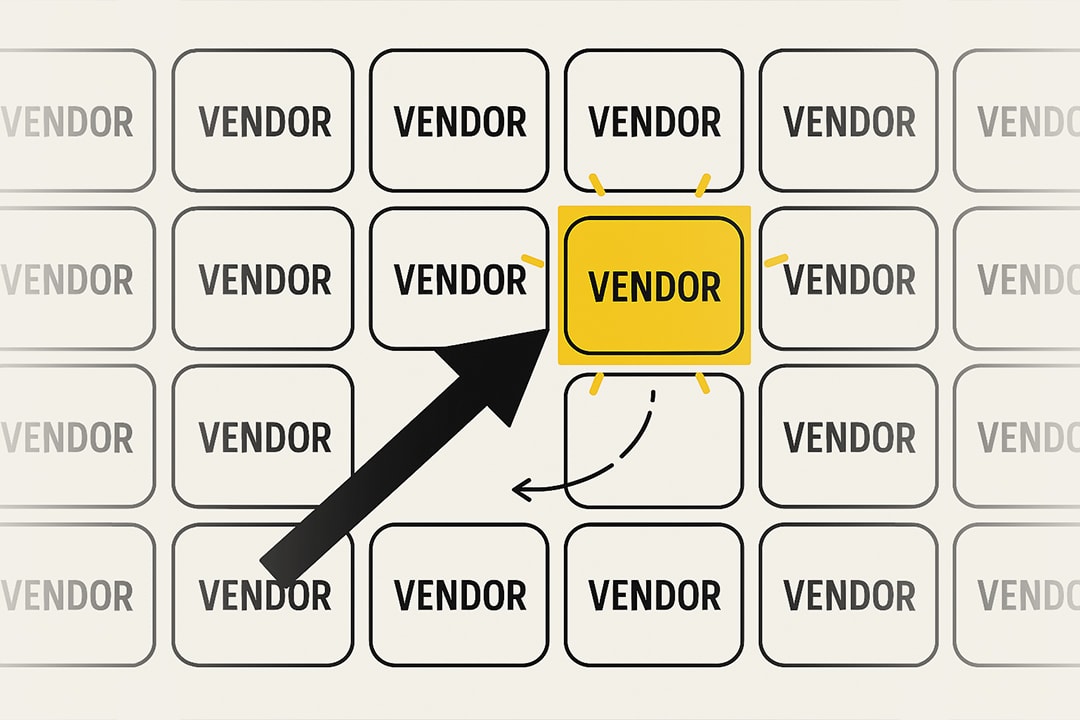How to Choose the Right IT Vendor and Never Regret Your Decision
Choosing the wrong IT vendor can cripple projects and budgets. Learn a research-backed, question-driven evaluation process that exposes hidden risks, benchmarks true fit, and empowers IT leaders to make confident, strategic vendor decisions every time.

TL;DR
- Choosing the wrong IT vendor can lead to project failures, hidden costs, and long-term business risk.
- A structured, question-driven checklist exposes red flags and reveals which vendors truly fit your needs.
- Scoring and benchmarking vendors objectively leads to better decisions and higher project success rates.
- Transparency on pricing, data ownership, support, and integration is non-negotiable for IT leaders today.
- Owning the vendor evaluation process turns procurement from a gamble into a strategic advantage.
Why choosing the wrong IT vendor is a risk you cannot afford
Every IT leader knows the feeling. The contract is signed, the onboarding calls are scheduled, and the new vendor promises a solution that will finally move the business forward. Fast forward six months, and what looked like a strategic win is now a source of endless escalation calls, surprise invoices, and growing internal frustration. The project is stalled, the board is skeptical, and the “trusted partner” has quietly become a liability.
Why one bad vendor decision ripples across the entire business
Vendor selection doesn’t just impact a single project. The repercussions echo through operations, security, budgets, and even your own credibility. According to Gartner, 60% of major IT project failures can be traced back to poor vendor selection or misalignment between vendor capabilities and business needs.
When the wrong fit is made, the consequences are rarely limited to missed features or clunky UX. Instead, they show up in hidden costs, integration failures, and support tickets that never seem to close.
Consider what happens when data ownership is unclear. Suddenly, offboarding becomes a negotiation, not a process. Or when support SLAs are loose and escalation paths are murky, minor incidents can spiral into outages that impact customers. Vendor lock-in is another silent threat, with McKinsey reporting that 73% of IT leaders now cite it as a top concern, often only realizing how trapped they are when it’s too late.
Why the old ways of choosing vendors no longer work
Vendor relationships used to be built on personal rapport, a few reference calls, and a glossy demo. Today, that approach is dangerously outdated. The complexity of modern IT stacks and the rise of SaaS, cloud, and managed services have made the stakes much higher. Projects now span hybrid environments, integrate with dozens of APIs, and carry data privacy and security liabilities that can’t be shrugged off.
The traditional “RFP and hope” method leaves too much to chance. Vendors are experts at highlighting strengths and sidestepping weaknesses. Without a systematic, question-driven approach, red flags stay hidden until the renewal cycle—or a crisis—forces them into the spotlight.
The hidden costs of vendor missteps
It’s not just direct costs that sting. Forrester found that organizations using formal, question-driven evaluation processes reported a 30–40% higher project success rate than those that relied on intuition or relationships alone. The hidden costs of a poor vendor fit quickly add up:
- Time lost in endless troubleshooting and escalations
- Budget overruns from surprise fees and additional service modules
- Reputational risk occurs when outages or security gaps affect customers
- Technical debt from rushed integrations or unsupported features
- Team morale dips as internal staff are left to “make it work” with a tool that was never right
Why a structured, evidence-driven approach is the only safe bet
The answer isn’t more meetings or endless bake-offs. It’s about building rigor into the evaluation process. The most resilient IT leaders use frameworks and scoring systems to evaluate every vendor, pinning them down on real-world outcomes, transparent pricing, integration history, support benchmarks, and data ownership. They don’t just ask “Can you do X?” They ask “Show us where you’ve done X for a company like ours, and let us talk to them directly.”
This approach doesn’t eliminate all risk, but it puts the odds—and the evidence—back in your favor. With the right process, the next vendor relationship can be a force multiplier, not a silent saboteur lurking in the background.
How to cut through sales hype and uncover the real vendor fit
The vendor selection process is a minefield of polished demos, persuasive sales pitches, and well-rehearsed promises. Every vendor claims to be a “partner,” every product is “enterprise ready,” and every implementation is “fast and seamless.” Yet, many IT leaders have learned the hard way that reality rarely matches the pitch. The real challenge is separating marketing spin from operational truth before any deal is signed.
Why a structured checklist exposes what really matters
The difference between a successful vendor relationship and a regretful one often comes down to the questions asked before the contract is inked. A structured, evidence-based checklist removes ambiguity, sets clear expectations, and flushes out red flags that would otherwise stay hidden. This approach empowers IT leaders to move past surface-level answers and zero in on the factors that drive long-term success.
Here’s a detailed 10-question checklist, built on the principles of the most recent industry research and proven to reveal the real story behind any vendor.
The 10-Question IT vendor evaluation checklist
1. What is the most recent, real-world use case you have solved for an organization of our size and industry? What measurable outcome did you deliver?
Look for specifics and direct parallels, not broad claims or hypotheticals. A solid vendor has fresh, relevant success stories and can articulate actual results, not just features.
2. Can you walk through the full implementation timeline for a customer like us—including what typically causes delays or bottlenecks?
Transparency around obstacles signals maturity. Vendors should openly discuss where projects slow down and how they handle the unexpected.
3. Which systems, platforms, or tools have you successfully integrated with in the past 12 months? Can you provide technical references or documentation?
Integration is where most projects stumble. Ask for documentation and references, not just assurances. If integration is “always easy,” be skeptical.
4. Who owns the data—including backups and logs—within your platform? How do you support data export or migration if we choose to leave?
Data ownership and portability are critical for avoiding lock-in. The vendor should have a clear, documented process for full data export and deletion.
5. What are the three most common reasons customers leave your platform, and how have you addressed these issues?
No solution is perfect. Honest vendors will admit where they have lost business and what they have done to fix root causes. Evasion is a warning sign.
6. Can you describe your support escalation process and share actual SLA metrics from the past quarter?
Ask for real support data, not just “24/7 support” claims. Press for average response and resolution times, and clarity on how issues get escalated.
7. How do you handle critical security incidents or breaches? Can you share a recent example and your communication protocol with customers?
Incident transparency is everything. A good vendor will show their process, not just say they “take security seriously.”
8. What is included in your quoted price, and what additional costs—services, modules, maintenance, increased usage—have surprised customers in the past?
Demand all-in pricing and sample invoices. Hidden or variable fees are one of the top reasons for budget overruns.
9. How is your product roadmap influenced by customer feedback? Can you share a recent feature that was added or improved based on client input?
Vendors who actually listen can point to real examples where customer needs drove product evolution.
10. If we ask for three references at companies similar to ours, can you provide direct contacts for project leads—not just executives or sales champions?
References should be recent, relevant, and accessible. If references are delayed or avoided, that’s a red flag.
How to listen for red flags
It’s not just about the answers, but how they are delivered. Watch for vague language, delayed responses, or reluctance to provide documentation. Typical red-flag phrases include:
- “Integration should be straightforward for most customers.”
- “We typically don’t provide references until late in the process.”
- “Let’s not get bogged down in details right now.”
- “Our pricing is customized and best discussed after the demo.”Each of these signals a need to dig deeper or consider walking away.
Why this process delivers results
Organizations that implement question-driven, checklist-based evaluations report up to 40% higher project success rates and fewer post-contract surprises (Forrester). A robust checklist not only protects against immediate risks but also sets the tone for an accountable, transparent vendor relationship from day one.
The next time a vendor claims their solution will change your world, remember: the right questions don’t just cut through the hype—they reveal whether the vendor can truly deliver when it counts.
How to score, compare, and benchmark IT vendors like a pro
The difference between a costly vendor mistake and a strategic win often comes down to what happens after the demos are over. At this stage, gut instinct and “they seemed nice” should give way to hard data and side-by-side analysis. The goal is to cut through bias, quantify trade-offs, and set the stage for a partnership that delivers real value—not just empty promises.
Why objective scoring beats instinct every time
Instinct is valuable in relationships, but it is a liability in high-stakes technology procurement. According to Gartner, organizations that use structured, criteria-based scoring grids report significantly fewer regrets and a higher rate of project success. Gut feel is swayed by charisma, recency bias, and the last sales pitch. A scoring system levels the playing field, allowing the best-fit vendor—not just the best talker—to rise to the top.
How to build a vendor scoring grid that works
Start by listing the criteria that matter most for your business, using the 10-question checklist as the foundation. Common categories include:
- Relevant experience and use cases
- Integration capability
- Data ownership and portability
- Support and SLAs
- Security and compliance posture
- Transparent pricing
- Customer references
- Responsiveness and transparency
- Roadmap and innovation
- Exit strategy
Score each vendor on a 0–2 or 0–3 scale (e.g., 0 = No/Red Flag, 1 = Partial/Unclear, 2 = Yes/Strong). Total the scores for a quick, side-by-side view of strengths and weaknesses. For more nuance, apply weightings to criteria that are mission-critical for your environment, such as integration or security if you operate in a regulated industry.
How to use industry benchmarks for context
The scoring grid is your internal compass, but industry benchmarks provide the map. Leverage frameworks from Forrester Wave and the Gartner Magic Quadrant to understand where vendors stand on innovation, execution, and market presence. But remember, these reports are a starting point, not the finish line. A “leader” in a Magic Quadrant may not be the right fit for your unique needs or your budget.
For extra rigor, ask vendors how they perform against external benchmarks. What are their average support times compared to industry averages? How do their security certifications stack up? Are they recognized by independent third-party reviews such as Gartner Peer Insights?
Why stakeholder alignment makes or breaks the process
Bring business, technical, and procurement stakeholders into the scoring process early. This ensures that requirements are clear, trade-offs are visible, and no single perspective dominates. A strong scoring grid helps prevent last-minute surprises, like an executive vetoing the top choice because nobody flagged a compliance dealbreaker.
Why “Support and Escalation” deserves extra scrutiny
Too many IT leaders focus on features and price, only to be blindsided by poor support post-launch. Make “support and escalation” a weighted category. Demand real SLA metrics, escalation paths, and reference calls with customers who have experienced major incidents. According to Gartner, 38% of failed projects cite post-sale support as a major factor.
How to use the scoring results
Once scores are tallied, do not hide them. Present findings to your leadership team with the criteria, weights, and evidence behind every score. The result is a defensible, transparent decision that stands up to scrutiny from stakeholders, auditors, or the board.
A scoring grid is not just a spreadsheet; it is a risk management tool, a communication framework, and the backbone of a vendor relationship built on facts, not fiction. This is how IT leaders turn procurement from a guessing game into a strategic advantage.
Why IT leaders win when they own the vendor evaluation process
Owning the vendor evaluation process is no longer a luxury for IT leaders—it is a necessity. The days of delegating critical technology decisions to procurement, relying on word-of-mouth, or letting sales pitches drive the agenda are gone. Today’s environment demands rigor, transparency, and cross-functional alignment. The IT leaders who embrace this reality consistently deliver better outcomes for their organizations and their teams.
Why process drives success
A formal, question-driven evaluation process is not about bureaucracy, but about control and clarity. Forrester’s research shows that organizations using structured, checklist-based evaluations achieve project success rates up to 40% higher than those that rely on informal methods. This is not just about making a “safe” choice—it is about picking a vendor who will move the business forward, avoid budget overruns, and deliver real, measurable value.
When IT leaders champion the process, the business benefits. Stakeholders know the criteria, risks are surfaced early, and decisions are based on evidence, not gut feel or political pressure. The result is less time wasted on failed pilots, fewer escalations, and a dramatically lower risk of post-contract regret.
How to institutionalize vendor evaluation
Winning teams make the vendor checklist and scoring grid a non-negotiable part of every procurement cycle. They build frameworks that can be reused and refined, aligning IT, business, and procurement around shared goals. The best leaders turn these tools into living documents—updating questions as the market evolves and treating every major vendor selection as a chance to improve the process.
Institutionalizing the process also means setting expectations with vendors. When suppliers understand that decisions are driven by transparent, evidence-based criteria, they are more likely to be honest about limitations, proactive about support, and invested in the partnership for the long haul.
Why true partners outperform commodity suppliers
A disciplined evaluation process does more than weed out weak vendors—it attracts strong ones. The best suppliers want to be measured on outcomes, not just promises. They respect customers who ask tough questions and welcome opportunities to demonstrate value. Over time, these relationships become true partnerships, where both sides are invested in success and accountability flows in both directions.
Research from Gartner and CIO.com reinforces this point: the right partner is not just a vendor, but a strategic asset. They help you navigate change, innovate faster, and respond quickly when things go wrong.
The leadership imperative
Ultimately, owning the vendor evaluation process is about protecting your business, your people, and your reputation. It is a way to ensure that every dollar spent moves the organization closer to its goals, not into a cycle of technical debt and finger-pointing.
The IT leaders who take this responsibility seriously are the ones who consistently deliver successful projects, build trust with stakeholders, and turn procurement from a source of anxiety into a source of competitive advantage. In a world where vendor choices make or break outcomes, there is no smarter bet than to own the process, drive the rigor, and set the standard for what good looks like.
FAQs
1. What are the most important questions to ask when evaluating an IT vendor?
Ask about recent use cases, integration experience, data ownership, support processes, transparent pricing, customer references, and how they handle security incidents. These questions reveal real-world reliability and transparency.
2. How can IT leaders avoid vendor lock-in and hidden costs?
Demand clear data export policies, comprehensive pricing breakdowns, and sample invoices. Insist on a written exit strategy and review all contract terms for hidden fees or dependencies before signing.
3. Why is a structured, scoring-based vendor evaluation process better than traditional methods?
Structured checklists and scoring grids minimize bias, highlight red flags early, and lead to 30–40% higher project success rates compared to informal, relationship-based selections.
4. What are red flags to watch out for in vendor responses?
Be wary of vague answers, reluctance to share references, unclear pricing, “should work” integration claims, and resistance to discussing customer churn or support metrics.
5. How often should IT leaders review and update their vendor evaluation process?
Review and refine your evaluation checklist and scoring system at least annually or after any major vendor issue, ensuring alignment with new industry risks, regulations, and business needs.





